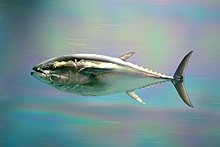Pacific bluefin tuna
| Pacific bluefin tuna | |
|---|---|
 |
|
| At Kasai Rinkai Park, Japan | |
| Scientific classification | |
| Kingdom: | Animalia |
| Phylum: | Chordata |
| Class: | Actinopterygii |
| Order: | Perciformes |
| Family: | Scombridae |
| Genus: | Thunnus |
| Subgenus: | Thunnus |
| Species: | T. orientalis |
| Binomial name | |
|
Thunnus orientalis (Temminck and Schlegel, 1844) |
|
| Synonyms | |
|
|
The Pacific bluefin tuna (Thunnus orientalis) is a predatory species of tuna found widely in the northern Pacific Ocean, but it is migratory and also recorded as a visitor to the south Pacific.
In the past it was often included in T. thynnus, the 'combined' species then known as the northern bluefin tuna (when treated as separate, T. thynnus is called the Atlantic bluefin tuna). It may reach as much as 3 m (9.8 ft) in length and 450 kg (990 lb) in weight.
Like the closely related Atlantic bluefin and southern bluefin, the Pacific bluefin is a commercially valuable species and several thousand tonnes are caught each year, making it overfished. It is considered threatened by the IUCN and PEW.Monterey Bay Aquarium's Seafood Watch program have placed all bluefin tunas on the "Avoid" list, and they are also placed on the "Red List" by Greenpeace and the Blue Ocean Institute.
According to the International Scientific Committee for Tuna and Tuna-Like Species in the North Pacific Ocean (ISC) who assessed the stock in 2011 and 2014, Pacific bluefin tuna populations are at 4% what they would be if fishing had never occurred.
Almost all fish are cold-blooded (ectothermic). However, tuna and mackerel sharks are warm-blooded: they can regulate their body temperature. Warm-blooded fish possess organs near their muscles called retia mirabilia that consist of a series of minute parallel veins and arteries that supply and drain the muscles. As the warmer blood in the veins returns to the gills for fresh oxygen it comes into close contact with cold, newly oxygenated blood in the arteries. The system acts as a counter-current heat exchanger and the heat from the blood in the veins is given up to the colder arterial blood rather than being lost at the gills. The net effect is less heat loss through the gills. Fish from warmer water elevate their temperature a few degrees whereas those from cold water may raise it as much as 20 °C (36 °F) warmer than the surrounding sea.
...
Wikipedia

